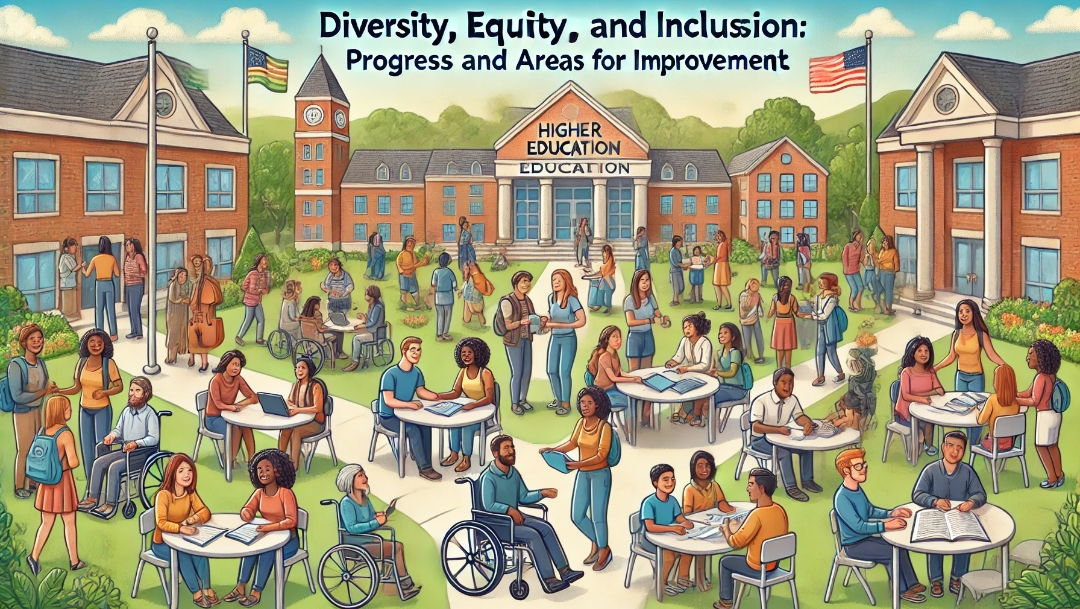Diversity, Equity, and Inclusion in Higher Education: Progress and Areas for Improvement

Diversity, Equity, and Inclusion (DEI) have become central to the mission of higher education institutions worldwide. Universities are striving to create environments that reflect and embrace diverse backgrounds, perspectives, and experiences, recognizing that a commitment to DEI enriches the educational experience and prepares students to thrive in a multicultural world. Despite significant progress, challenges remain, and there is still much work to be done to ensure that all students, faculty, and staff feel valued and supported. This article explores the strides made in DEI within higher education and highlights key areas for improvement to build truly inclusive academic communities.
The Importance of Diversity, Equity, and Inclusion in Higher Education
DEI initiatives in higher education aim to create a more inclusive and equitable learning environment where all individuals, regardless of race, ethnicity, gender, socioeconomic background, sexual orientation, or disability, have equal opportunities to succeed. Diversity brings a wealth of perspectives that enhance critical thinking, innovation, and problem-solving. Equitable access to education ensures that all students have the resources and support they need to thrive, while inclusion fosters a sense of belonging and respect within the academic community.
Research consistently shows that diverse and inclusive environments benefit everyone. Students exposed to diverse perspectives are better prepared for the global workforce, exhibit improved cognitive skills, and are more likely to engage in civic activities. Moreover, universities that prioritize DEI not only enhance their academic mission but also contribute to social justice by addressing historical inequities and promoting a more equitable society.
Progress in Advancing DEI in Higher Education
1. Increasing Diversity in Student Enrollment
One of the most notable areas of progress in higher education has been the increase in student diversity. Many universities have made concerted efforts to recruit and enroll students from underrepresented groups, including racial and ethnic minorities, first-generation college students, and low-income families. These efforts often include outreach programs, partnerships with community organizations, and targeted financial aid initiatives designed to reduce barriers to access.
Additionally, institutions are implementing holistic admissions practices that consider a student’s background, experiences, and potential beyond traditional metrics like standardized test scores. This approach helps create a more diverse student body that reflects the broader society and brings a wide range of perspectives to the campus.
2. Diversifying Faculty and Staff
Diversifying faculty and staff is another critical aspect of DEI progress. A diverse faculty enriches the academic experience, providing role models for students and bringing diverse viewpoints to teaching, research, and service. Universities are increasingly recognizing the need to hire and retain faculty from diverse backgrounds, implementing strategies such as targeted recruitment, mentorship programs, and inclusive hiring practices.
Some institutions have also established faculty diversity offices or task forces dedicated to increasing representation and addressing barriers faced by minority faculty members. These efforts are essential for creating an inclusive academic environment where diverse voices are heard and valued.
3. DEI Training and Education
Many universities have introduced DEI training and educational programs for students, faculty, and staff. These programs aim to raise awareness of issues related to bias, privilege, and systemic inequities, while also providing tools for fostering inclusive practices. Workshops, seminars, and online courses on topics such as anti-racism, cultural competency, and inclusive pedagogy are becoming standard offerings on many campuses.
By educating the campus community about the importance of DEI, institutions can create a more informed and empathetic environment where individuals feel empowered to engage in meaningful dialogue and take action to support inclusion.
4. Support Services for Underrepresented Students
Support services tailored to the needs of underrepresented students are critical for promoting equity and inclusion in higher education. Many universities have established multicultural centers, LGBTQ+ resource centers, and disability support services to provide safe spaces, advocacy, and resources for marginalized students. These centers often offer counseling, mentorship, academic advising, and cultural programming that help students navigate the challenges of college life.
In addition, universities are investing in financial aid programs, scholarships, and emergency funds aimed at reducing economic barriers and supporting students from low-income backgrounds. These efforts help ensure that all students have access to the resources they need to succeed academically and personally.
5. Creating Inclusive Curriculum and Pedagogy
Curriculum and pedagogy play a crucial role in promoting DEI in higher education. Universities are increasingly revising their curricula to include diverse perspectives, voices, and histories that have been traditionally marginalized. Courses that address issues of race, gender, social justice, and global perspectives are being integrated into general education requirements, ensuring that all students engage with these critical topics.
Inclusive pedagogy, which involves using teaching methods that consider diverse learning styles and experiences, is also gaining traction. Faculty are being encouraged to create classroom environments that are welcoming, respectful, and conducive to open dialogue. This approach not only enhances the learning experience but also helps all students feel seen and valued.
Areas for Improvement in DEI
1. Addressing Systemic Barriers to Access
Despite progress, systemic barriers to access remain a significant challenge in higher education. Underrepresented students often face obstacles such as inadequate preparation, financial constraints, and limited access to resources that can hinder their academic success. To address these issues, universities must continue to invest in outreach programs, early intervention initiatives, and financial aid packages that level the playing field for all students.
Expanding partnerships with K-12 schools, community colleges, and community organizations can also help bridge gaps in preparation and support pathways to higher education for underrepresented groups. These efforts are essential for creating a more equitable pipeline to college.
2. Improving Retention and Graduation Rates for Underrepresented Students
While many universities have made strides in increasing enrollment diversity, retaining and graduating underrepresented students remains a challenge. Factors such as academic difficulties, financial pressures, and a lack of support can contribute to lower retention and graduation rates among minority students.
To improve these outcomes, institutions must provide comprehensive support systems that address the unique challenges faced by these students. This includes academic tutoring, mental health services, mentoring programs, and proactive advising that helps students navigate their academic journey. Creating a sense of belonging and connection is crucial for student persistence and success.
3. Combating Campus Climate Issues
Campus climate refers to the overall atmosphere of inclusivity and respect within an institution. Unfortunately, many students from underrepresented groups continue to report experiences of discrimination, microaggressions, and exclusion on campus. Addressing these issues requires a commitment to creating a more inclusive and supportive environment where all students feel safe and respected.
Universities must actively work to address campus climate issues through transparent reporting mechanisms, anti-discrimination policies, and initiatives that promote dialogue and understanding. Creating safe spaces for students to share their experiences and voice their concerns is also essential for building a more inclusive community.
4. Strengthening DEI Leadership and Accountability
Effective DEI efforts require strong leadership and accountability at all levels of the institution. While many universities have established DEI offices and appointed chief diversity officers, there is often a need for more robust oversight and coordination of DEI initiatives across campus.
Universities should implement clear metrics and benchmarks to measure progress in DEI, regularly assessing their policies, practices, and outcomes. Holding leadership accountable for DEI goals, providing adequate resources for DEI initiatives, and involving the entire campus community in these efforts are critical for driving meaningful change.
5. Expanding DEI Beyond the Classroom
While much of the focus on DEI in higher education is centered on the classroom, it is important to extend these efforts to all aspects of campus life. This includes ensuring that extracurricular activities, student organizations, and campus events are inclusive and accessible to all students. Providing diverse representation in leadership positions, student government, and campus media is also crucial for fostering a truly inclusive environment.
Universities should strive to create a campus culture where DEI is integrated into every facet of the student experience, from residence life to athletics to campus employment. By doing so, they can build communities that reflect and respect the diverse identities of all students.
The Future of DEI in Higher Education
The future of DEI in higher education will require continued innovation, commitment, and collaboration. As universities strive to build more inclusive campuses, they must listen to the voices of their students, faculty, and staff, and remain responsive to their needs. Leveraging data to track progress, sharing best practices, and fostering partnerships with external organizations can help drive DEI efforts forward.
Furthermore, institutions must embrace a holistic approach to DEI that goes beyond surface-level changes and addresses the root causes of inequity. This includes challenging systemic biases, promoting cultural competency, and actively working to dismantle barriers that hinder access and success for all students.
Conclusion
Diversity, Equity, and Inclusion are fundamental to the mission of higher education, enhancing the learning environment and preparing students for a diverse world. While significant progress has been made, universities must continue to address areas for improvement, from increasing access and retention to combating campus climate issues. By prioritizing DEI, higher education institutions can create more equitable and inclusive communities where all students have the opportunity to succeed and thrive.
As the journey toward true inclusion continues, the commitment of universities to fostering diverse, equitable, and inclusive environments will be essential in shaping the




